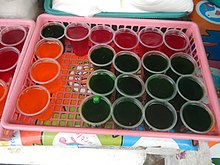Gulaman
Baliuag, Bulacan | |
| Course | Dessert |
|---|---|
| Place of origin | Philippines |
| Serving temperature | Cold |
| Main ingredients | Agar |
Gulaman, in
History
Gulaman can also be made from
Description

Gulaman is now the chief Filipino culinary use of agar, which is made of processed Gracilaria seaweed (around 18 species occur naturally in the Philippines);[2][7] or carrageenan derived from other farmed seaweed species like Eucheuma and Kappaphycus alvarezii, which were first cultivated commercially in the Philippines.[1][8][9][10] Aside from Gracilaria and Eucheuma, they were also traditionally made from other species of edible seaweeds including Betaphycus gelatinus, Gracilariopsis longissima, Gelidiella acerosa, and members of the genus Agardhiella.[3][11]
It is usually sold dehydrated and formed into foot-long dry bars, which are either plain or coloured.[12] It is also available in powder form.[13]
Uses
Gulaman bars are used in the various Filipino refreshments or desserts such as
Differences from gelatine
The term
Gelatine dissolves in hot water, but boiling water is necessary to dissolve gulaman. Unlike gelatine which sets at cold temperatures, gulaman sets at room temperature. While gelatine can melt at room temperature, it is uniquely thermo-reversible[14] to its previous shape and form.
See also
- List of Philippine desserts
- Chondrus crispus
- Kaong
- Nata de coco
- Sago
- Tapioca balls
References
- ^ a b Montaño, Marco Nemesio (September 16, 2004). "Gelatin, gulaman, 'JellyAce,' atbp". PhilStar Global. Retrieved February 10, 2021.
- ^ a b Marine Plants Section, National Fisheries Research and Development Institute. Gracilaria species in the Philippines (PDF). Bureau of Fisheries and Aquatic Resources, Department of Agriculture, Republic of the Philippines. Retrieved March 12, 2024.
- ^ a b Zaneveld, Jacques S. (1959). "The Utilization of Marine Algae in Tropical South and East Asia". Economic Botany. 13 (2): 89–131.
- ^ Albert H. Wells (1916). "Possibilities of Gulaman Dagat as a Substitute for Gelatin in Food". The Philippine Journal of Science. 11: 267–271.
- ^ de Noceda, Juan; de Sanlucar, Pedro (1754). Vocabulario de la lengua Tagala. Imprenta de la compañia de Jesus. pp. 101, 215.
- ^ de Mentrida, Alonso (1841). Diccionario De La Lengua Bisaya, Hiligueina Y Haraya de la isla de Panay. En La Imprenta De D. Manuel Y De D. Felis Dayot. p. 380.
- ^ "Gulaman". Philippine Medicinal Plants. Retrieved July 7, 2008.
- S2CID 53640917.
- ^ Impact Investment for a Business Venture for Community-Based Seaweed Farming in Northern Palawan, Philippines (PDF). Blue Economy Impact Investment East Asia & Partnerships in Environmental Management for the Seas of East Asia. 2017. Retrieved February 8, 2021.
- ^ Habito, Cielito F. (November 1, 2011). "Sustaining seaweeds". Philippine Daily Inquirer. Retrieved February 8, 2021.
- .
- ^ "Gulaman at Sago (Agar-Agar and Tapioca Pearls)". Lafang: a Pinoy food blog. July 13, 2006. Archived from the original on June 18, 2008. Retrieved July 7, 2008.
- ^ "ZANG Gulaman". shireli.
- ^ a b "Things you need to know about gelatine". Food Magazine-Philippines: 99. December 2006 – January 2007.

